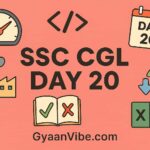GyaanVibe is a focused educational platform dedicated to helping SSC CGL aspirants crack Tier 1 & Tier 2 exam with a strategic, day-wise, and well-structured preparation approach.
SSC CGL Preparation – Day 11
MCQs: Government Structure
1. Who is the real executive head of the Union Government of India?
A) President
B) Prime Minister
C) Vice-President
D) Cabinet Secretary
✅ Answer: B) Prime Minister
🧠 Explanation: Though the President is the nominal head, the Prime Minister exercises real executive power.
2. Which article of the Constitution deals with the composition of the Parliament of India?
A) Article 52
B) Article 79
C) Article 74
D) Article 124
✅ Answer: B) Article 79
🧠 Explanation: Article 79 mentions that Parliament consists of the President, Rajya Sabha, and Lok Sabha.
3. The system of Panchayati Raj was constitutionalized through which amendment?
A) 42nd
B) 52nd
C) 73rd
D) 44th
✅ Answer: C) 73rd
🧠 Explanation: The 73rd Constitutional Amendment (1992) granted constitutional status to the Panchayati Raj system.
4. Which of the following is NOT a part of the Union Executive?
A) President
B) Vice-President
C) Chief Justice of India
D) Prime Minister
✅ Answer: C) Chief Justice of India
🧠 Explanation: The Chief Justice is part of the Judiciary, not the Executive.
5. What is the minimum age to become a member of the Lok Sabha?
A) 21 years
B) 25 years
C) 30 years
D) 35 years
✅ Answer: B) 25 years
🧠 Explanation: Article 84(b) states that the minimum age to contest Lok Sabha elections is 25.
6. The President of India is elected by:
A) Direct elections by citizens
B) Lok Sabha members only
C) Elected members of Parliament and State Legislatures
D) Prime Minister and Cabinet
✅ Answer: C) Elected members of Parliament and State Legislatures
🧠 Explanation: The President is elected indirectly by an Electoral College comprising elected MPs and MLAs.
7. The Vice-President of India is also the:
A) Speaker of Lok Sabha
B) Governor of Delhi
C) Chairman of Rajya Sabha
D) Cabinet Secretary
✅ Answer: C) Chairman of Rajya Sabha
🧠 Explanation: The Vice-President acts as the ex-officio Chairman of Rajya Sabha.
8. The Supreme Court of India has how many types of jurisdiction?
A) Two
B) Three
C) Four
D) Five
✅ Answer: B) Three
🧠 Explanation: Supreme Court has Original, Appellate, and Advisory jurisdictions.
9. Which is the apex judicial body in India?
A) High Court
B) Lok Adalat
C) Supreme Court
D) Judicial Committee of Parliament
✅ Answer: C) Supreme Court
🧠 Explanation: Supreme Court is the highest judicial authority under the Constitution.
10. Urban local bodies are established under which amendment?
A) 73rd Amendment
B) 42nd Amendment
C) 74th Amendment
D) 44th Amendment
✅ Answer: C) 74th Amendment
🧠 Explanation: The 74th Amendment (1992) gave constitutional status to urban local bodies like municipalities.




